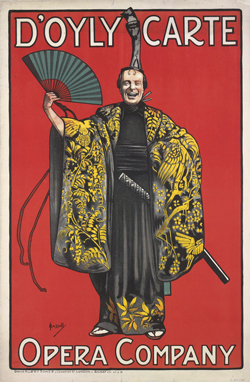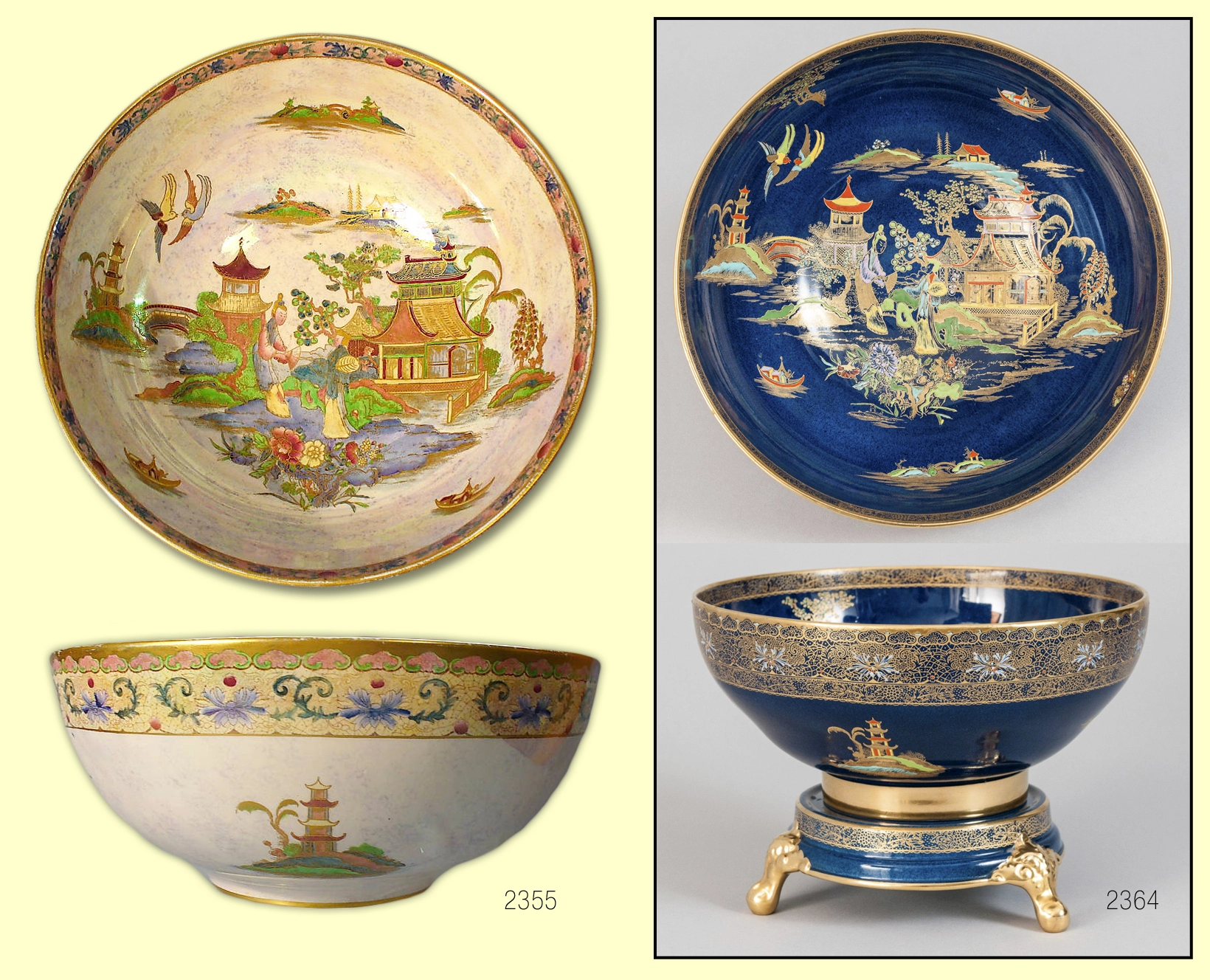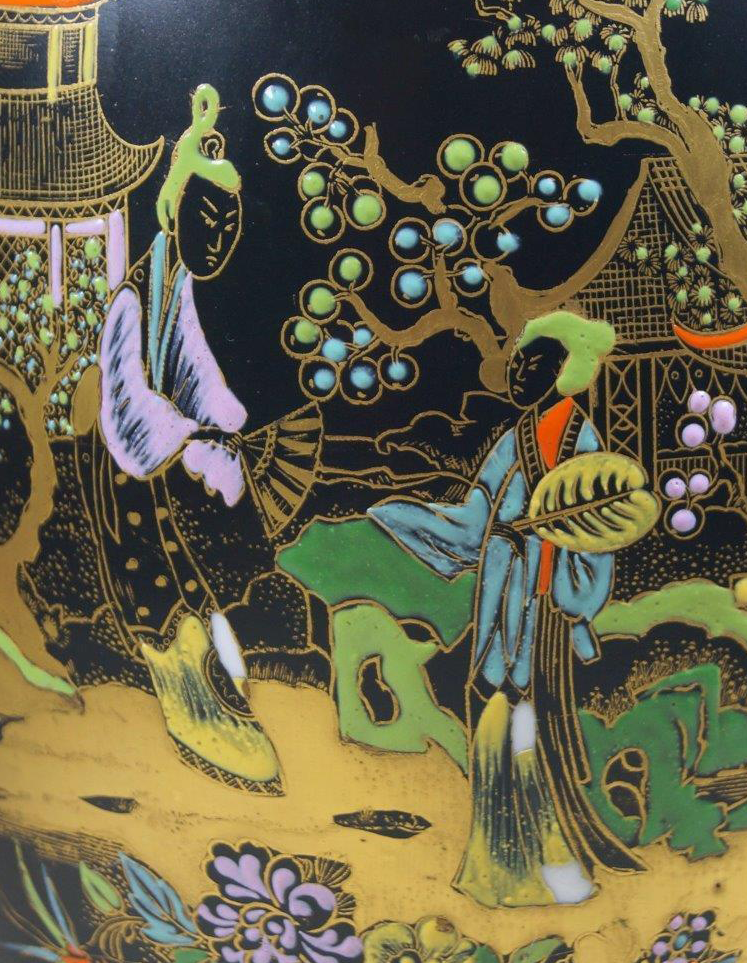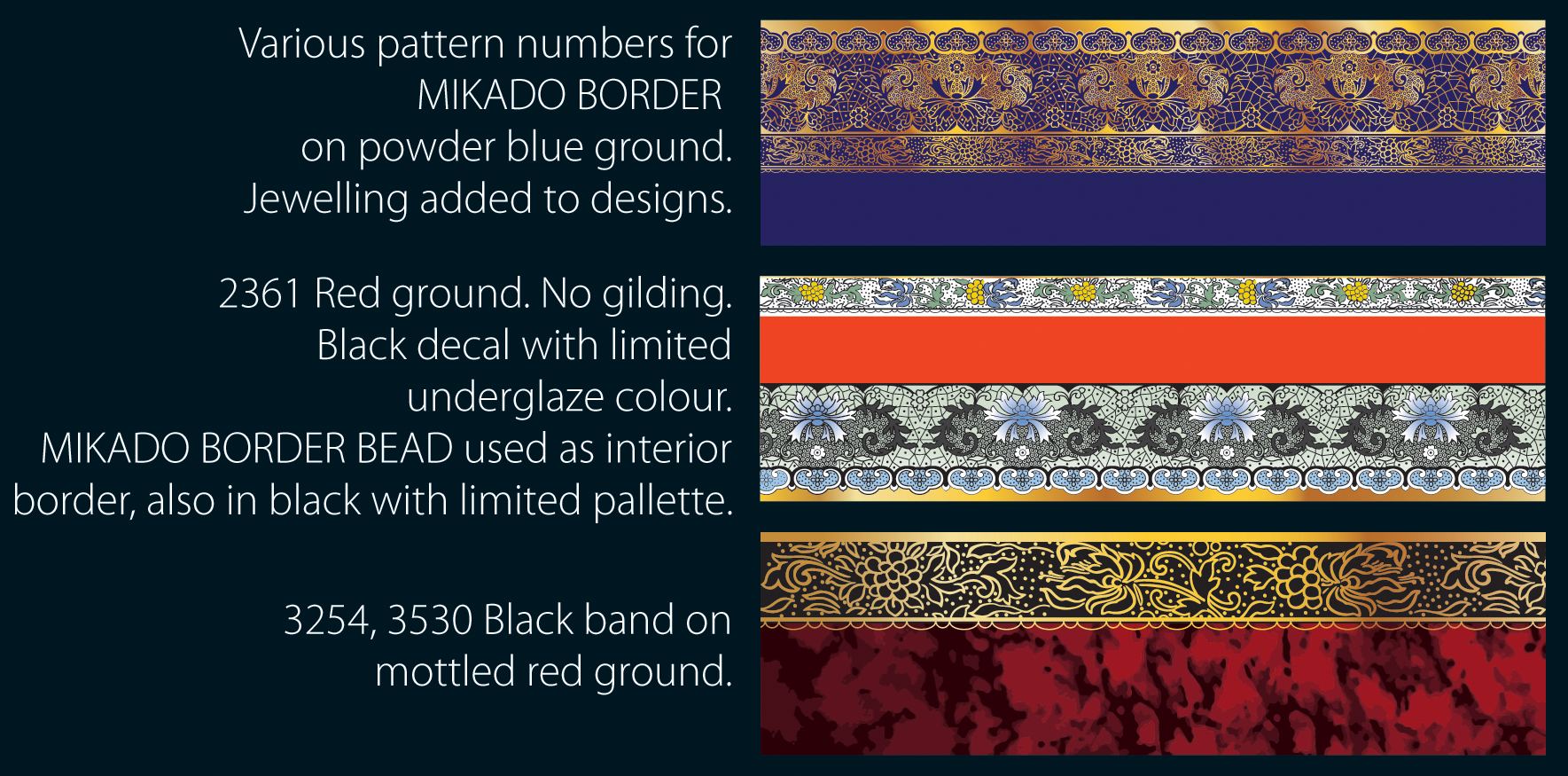

Notice a kanmuri on his head.
MIKADO
Carlton Ware's MIKADO pattern and its Borders
by Harvey Pettitwith border artwork by Barbara Anne Lee
Horace Wain's daughter, with whom I corresponded and interviewed in the 1990s, stated that her father “adored Gilbert and Sullivan” and on occasion would take the whole family to their operas. He is bound to have seen many, if not all, of the local performances by the touring D'oyle Carte Opera Company, who in the 1910s made many visits to the Theatre Royal in Stoke-on Trent. The Mikado, set in Japan, must have been one of their productions.
With his predilection for Oriental ceramics, it is no surprise that one of Wain's designs was inspired by and named after Gilbert & Sullivan's witty satire of nineteenth-century British politics and institutions. According to the trade press of the time, Carlton Ware's namesake pattern MIKADO was introduced in 1920 and was to prove to be one of Wain's most enduring patterns.
Below are two variants of the MIKADO pattern that illustrate how its wide elaborate border could be used. This depended not only on shape but also size. If space allowed the whole border was employed, if not part was used.
Later in this article, Barb illustrates how the border was cut into sections.

To see these bowls fit your device's screen and/or enlarge it click or tap on them.
To return to this page use your back button.
Notice how different the pattern and border can look. Compare it when painted in underglaze colours and gold printed (left), with it being gold printed and raised enamelled against a POWDER BLUE ground (right).
Horace Wain's MIKADO takes elements from several well-known eighteenth century Chinese patterns. The birds from Wain's earlier WILLOW are also present. The pattern remained in production for almost 70 years though shortly after Gerald and Anthony Wood bought the Carlton Works in 1968, they ceased printing patterns from copper plates. To replace this labour intensive time-honoured decorating technique, the new owners introduced a gold slide-on lithograph, which copied the original pattern. Lithographs required less skill to apply. The gold lithos gave a flatter appearance (unnoticed by many). As with gold printed patterns, the raised enamels were applied on top of the gold litho. Borders were not used on these later variants.
NOTE - In the Wood's period (1967-1987), Best Ware patterns were greatly reduced and in advertising material the lithograph of the MIKADO pattern was renamed PAGODA.

The figure on the right might be Yum-Yum or Katisha.
The Figures
At first, the two figures central to the pattern appear to be geishas but the figure on the left looks to be wearing a kanmuri, the standard headwear worn by adult men at the Japanese imperial court, including the Emperor. The figure is also holding a fan, which is how the Mikado was usually portrayed on theatre posters during the early 1900s. I think, therefore it safe to say that the left figure represents the Mikado, the Emperor of Japan, though of course the biggest clue is in the pattern name.
Identifying the figure on the right is more difficult but must be female (or at least identifies as female, though we will never know their preferred pronouns). My guess is that it is probably meant to be Yum-Yum or the older Katisha.
In the greatly enlarged image on the right, you can see how precise the raised enamellers were with their brush work. The gold printing and gilders work are also second to none.
To see this detail fit your device's screen and/or enlarge it click or tap it.
To return to this page use your back button.
MIKADO BORDER & its uses
MIKADO was an elaborate pattern with an even more elaborate border.
Below is Barb's representation of the full MIKADO BORDER in all its glory.
 © Barbara Anne Lee 2023
© Barbara Anne Lee 2023 To enlarge Barb's image of the full MIKADO BORDER above, click or tap on it.
Use your back button to return to this article.
Good in parts too
The full MIKADO BORDER was sometimes too wide to sit well on some of the smaller shapes. Consequently, parts of the border were used as below.
Firstly, Part MIKADO BORDER
 © Barbara Anne Lee 2023
© Barbara Anne Lee 2023 To enlarge Barb's image of the full Part MIKADO BORDER above, click or tap on it.
Use your back button to return to this article.
Secondly, MIKADO BORDER BEAD
 © Barbara Anne Lee 2023
© Barbara Anne Lee 2023 To enlarge Barb's image of the MIKADO BORDER BEAD above, click or tap on it.
Use your back button to return to this article.
MIKADO BORDER BEAD leant itself for use on other patterns, DRAGON, for example, which did not have a dedicated border.
MIKADO BORDER was also used on Carlton Ware's later NEW MIKADO pattern devised by Wain's successor Enoch Boulton. Clearly, there was no need to create another border for a similar pattern. This avoided the considerable expense of a new copperplate engraving. It is from these flat metal plates that patterns and borders were printed onto tissue paper to be transferred onto ware.
Under the direction of Enoch Boulton, other borders were used on his MIKADO variants especially those that used a contrasting ground colour for the border.
Below Barb illustrates how the border looks on different MIKADO variants.
 © Barbara Anne Lee 2023
© Barbara Anne Lee 2023 To enlarge Barb's image of various MIKADO BORDER above, click or tap on it.
Use your back button to return to this article.
Barb's work on these borders was greatly assisted by Betty Maxworth, Chris Rutter and Chris Meallin, who all supplied beautiful close ups. Thank you.
The next pattern in the sequence of Horace Wain's Chinoiserie patterns with an associated border is Bird & Tree Peony.
© Copyright Harvey Pettit.
V4. First published April 2024 - small edits May & August 2024.
NOTE - To help you avoid mixing up pattern and shape names I use some simple typographic conventions. You can read them by clicking or tapping on the button on the left below.
Or